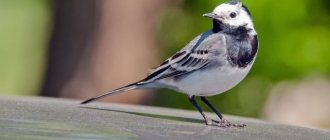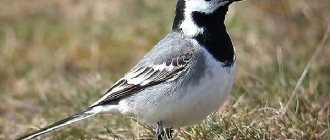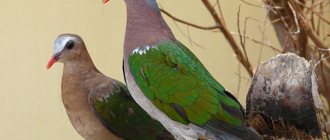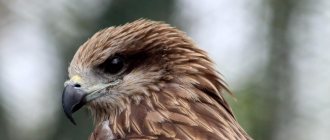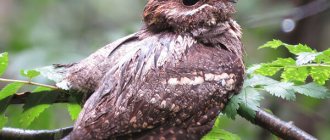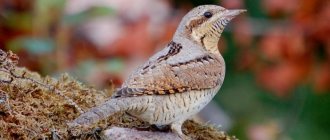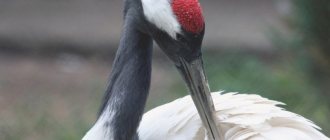The wagtail is a small songbird from the order Passeriformes, family Wagtail. Another name for the wagtail bird in Ukraine and some regions of Russia is pliska. It is also called the wagtail or pligavitsa. These birds are not afraid of people, so many individuals can be seen in the wild. They fly quite close to a person, literally at arm's length. In spring, their ringing melodic songs are heard everywhere. In this article we will talk about the most common types of wagtails, their appearance and features of the bird’s lifestyle. We’ll also talk about signs and legends associated with pliska.
The wagtail is a member of the wagtail family
Description of the bird
Wagtails are a genus of songbirds in the wagtail family, order Passeriformes, average body length - 20 cm, wingspan - 25 cm, weight 20g.
What does it look like
The predominant colors of plumage in birds are black, gray and white. The wagtail is distinguished by high legs, straight thin legs, a thin straight beak and a long tail, which the bird characteristically shakes while running along the ground in search of food. We can easily recognize the wagtail as a bird with a quivering tail.
Why is it called that?
— Advertising —
While hunting for food, the wagtail quickly moves along the ground in different directions and at the same time dynamically swings (shakes) its tail up and down. It is in this behavior that lies the answer to the question why the wagtail was called the wagtail (the bird shakes its tail). The tail is the wedge-shaped part of the bird's body; ass (dictionary by T. F. Efremov.)
Male and female: differences
Sexual dimorphism is weak. Typically, females and young animals look paler than males. In certain species, for example, the black-headed wagtail, significant differences are noticeable - the male is rich in color with bright black, yellow, and white colors, while the females look unremarkable and are colored in olive-brown tones.
How do wagtails reproduce and what kind of offspring do they produce?
Immediately after arriving from wintering in warm countries, the birds begin to choose and clear a place to build a nest where the chicks will live.
The mating season begins around March-April. At this time, males change their color to a brighter and more saturated one in order to attract the attention of the female. The rest of the time there are practically no differences between males and females, except that the former are slightly larger.
To find his beloved, the male fluffs his tail, dances, bows, squats around the female he likes and flaps his wings. Pairs form approximately 10–14 days after returning from wintering.
Both partners take part in the nesting process. Wagtails make a nest from branches, moss, leaves, and various roots. It has a cone shape.
From the inside, to keep the chicks warm, the wagtail nest is lined with animal hair and even human hair (if the birds nest near populated areas).
To breed their offspring, wagtails choose secluded places where it will be difficult for ill-wishers to penetrate:
- crevices between stones;
- hollows;
- between tree roots;
- cracks in the walls of houses, roofs, attics;
- inoperative or abandoned vehicles;
- rocks;
- grooves;
- small holes in the ground;
- sheds and woodsheds.
The main requirements for a nest site are seclusion and proximity to a body of water.
The wagtail usually lays eggs in early May. There are about 4–8 eggs in one clutch. They are small in size, matte, gray, dirty green or white with black speckles.
Birds most often breed once per season, but if someone has destroyed the nest, the wagtail can lay eggs a second time.
Only the female incubates the chicks. At this time, the male obtains food for the future mother, drives away enemies and entertains her with loud songs.
The offspring emerge after about two weeks, independently pecking through the eggshell. The male or female immediately takes her as far as possible from the nest so that she does not attract the attention of predators.
The babies are completely helpless, small, covered in fluff. They can be gray, white, yellowish or black. They have a bright yellow crop.
Wagtail with chicks
For about two more weeks, their mother and father feed them - they bring food and put it in their wide-open mouths. Then the babies grow feathers, and the chicks begin to learn to fly. They are becoming more and more independent, but all summer they are under the strict control of their parents, who warm them at night and teach them all the intricacies of adult life. In autumn, young chicks leave the nest and go to their first wintering place.
Wagtails are very good parents. They may even feign injury to lure humans or wild animals away from the nest. If this technique does not work, then they defend their nest with a loud cry, which is joined by all nearby wagtails. And they are flocking birds that live in large colonies.
THIS IS INTERESTING. People will often see tiny wagtail chicks sitting on the ground. They try to pick them up, thinking that the babies have fallen out of the nest or got lost. Under no circumstances should this be done - the wagtail will not accept such chicks into its nest, and they may die. The cubs sitting on the ground are fine. They are simply learning to fly and resting near their nest.
Lifestyle
— Advertising —
Most wagtails stay near water in separate families or small flocks; Wagtails nest on the ground or in hollows.
Migratory bird or not
Wagtails are migratory birds . But migratory behavior depends on the habitat of each specific population. Basically, all bird species in the northern regions are migratory birds. Wagtails winter in southern Europe, Asia, and Africa. Endemic to the African continent and the islands of Madagascar, they are sedentary birds.
Unlike most small birds, it moves on the ground not by jumping, but by running.
Nutrition
Wagtails feed exclusively on insects. Some of them, for example, dragonflies, are caught in flight. But much more often, when hunting, birds quickly run along the ground, and when stopping, they swing their long tail down and up.
Where does the wagtail live?
The small bird with a quivering tail can be found on almost all continents of the globe, with the exception of Antarctica. The bird lives in different landscape zones and regions:
- in the tundra and forest-tundra;
- wet meadows;
- mountains (no more than 3 km in height);
- tropical and subtropical forests;
- near populated areas and agricultural lands.
The wagtail does not live only in arid deserts, in areas covered with ice, and in dense impenetrable forests (with the exception of some species).
Most often, wagtails prefer to settle near bodies of water with clean water - rivers, lakes, mountain streams.
Most plisoks live in Eurasia.
Most wagtails live in Eurasia
There are many wagtails in Ukraine - several species of this bird live there. The wagtail is also found in Belarus - several million individuals prefer to settle in the territory of this country.
Recently, migratory wagtails were spotted in Israel - hundreds of birds hovered over its territory, which has not happened for 40 years.
Ornithologists believe that the first wagtails appeared in Mongolia and Eastern Siberia, and from there they spread throughout Eurasia and Africa.
Wintering wagtail or nomadic bird
The wagtail is a migratory bird. Although some species living in warm regions lead a sedentary lifestyle.
Birds migrate almost all autumn, flying south of their usual range - to Asia, southern Europe and Africa. Many birds are observed in winter on the banks of the Nile. Some species move to Central Europe. There, wagtails spend the winter near ice-free rivers.
At the end of summer, wagtails begin to flock together with other birds - swallows, starlings.
Birds learn that it is time to fly away with the help of hormones produced by the pituitary gland. This is also influenced by the length of daylight hours, which triggers the “migratory bird mode.” Before leaving, the gullible birds become very vigilant and do not let a person get closer than a few tens of meters to them.
They fly in small flocks, preferring to move at night or early in the morning. The flight path always runs along bodies of water. During rest, birds communicate with each other through singing. The flight to the wintering site takes an average of two months.
The first birds return home early, already at the beginning of March (of course, everything depends on weather conditions), when the snow begins to melt on the streets and the first puddles appear. People have noticed that the wagtail arrives at about the same time when ice drifts on the rivers. That's why it's sometimes called an icebreaker. Allegedly, the bird breaks the ice on reservoirs with its shaking tail.
There is a belief that the wagtail arrives after wintering and breaks the ice on the rivers
Spreading
Area
Most species of wagtails are widespread in Europe and Asia, some live in Africa.
Habitats
This is what a wagtail bird looks like sitting on a wire.
The white wagtail often settles near people. For nesting, these birds prefer areas located near fresh water bodies, lakes and rivers, as well as swampy areas and deciduous forests.
Populations and species status
Scientists and historians believe that the first birds from the wagtail family appeared several tens of millions of years ago. Their appearance was facilitated by a decrease in the number of forests and an increase in open spaces.
Since then, wagtails have spread throughout almost the entire globe, and their population numbers are stable. There are no sharp reductions or sharp increases in the number of individuals. Wagtails are a bird species of least concern.
However, due to anthropogenic activities, some species of wagtails have begun to decline. The following factors contribute to this:
- burning grass in the spring, which reduces the number of insects that birds feed on;
- laying eco-trails and developing hiking routes in wagtail habitats;
- construction of new settlements;
- laying of mains and heating mains;
- pollution of rivers and soil.
Burning grass in the spring leads to a reduction in the diet of wagtails.
Natural reasons for the decline in the population include the overgrowing of open meadow areas, where some bird species (for example, the yellow wagtail) live, with bushes, weeds and tall grass. If the area of the meadow becomes less than two hectares, they simply stop nesting and breeding.
To protect small species of wagtail, which cause concern among ecologists and ornithologists, rescue measures are used:
- identify and introduce bird nesting sites into the territories of nature reserves and sanctuaries;
- Every year the meadows are mowed away from natural thickets;
- increase the area of meadow areas;
- introduce fines for burning dead wood, conduct explanatory preventive conversations with the population;
- are trying to improve the ecological situation in the habitats and nesting areas of wagtails.
THIS IS INTERESTING. For 20 years now, the yellow wagtail has been considered a vulnerable species in the Moscow region. Since 2001, it has been included in the regional Red Book.
Kinds
White wagtail
Latin name : Motacilla alba Weight : 24 g Highest classification : Wagtails Conservation status : Least Concern
The bird's body length is 15-19 cm, weight 24 g. The plumage on the back is gray, the belly is white. The head is painted white, decorated with black feathers on the throat and in the form of a cap. The bird has a long tail, characteristic of the species.
The species is distributed in Asia, Europe, North Africa, and Alaska. In warm areas it is sedentary, and northern populations fly to Africa for the winter.
Mountain wagtail
Latin name: Motacilla cinerea Weight: 17 g Highest classification: Wagtails Conservation status: Least Concern
Body length is 17-20 cm, with a long tail characteristic of the species. The male's plumage during the nesting season is mostly gray on the back and yellow on the belly with white sides. The neck is black, which distinguishes the mountain wagtail from its closest relative, the yellow wagtail.
The bird lives in North Africa and Eurasia. The majority of the population are migratory birds that migrate to tropical Africa in winter.
For nesting, the mountain wagtail chooses areas near bodies of water - the banks of streams, rivers, swamps, wet meadows.
Long-tailed wagtail
Latin name: Motacilla clara Weight: 16 g Highest classification: Wagtails Conservation status: Least Concern
The bird is found in Africa (Angola, Burundi, Botswana, Cameroon) in tropical and subtropical mountain forests. The color of the plumage is dominated by shades of gray. The top of the bird is darker, the bottom is light gray. The wings are black and white.
Yellow wagtail
Latin name: Motacilla flava Weight: 18 g (adult) Highest classification: Wagtail Conservation status: Least Concern
The smallest representative of the wagtail genus with a body length of 15 cm and a weight of 18 g. The yellow wagtail is a slender bird with a long tail. The upperparts of males and females are gray with a greenish or brownish tint. The wings are brown-ochre. The tail is dark brown with white feathers. Legs are black. Subspecies of the bird differ in their characteristic patterns on the head.
A distinctive feature of the species is the bright yellow plumage of the belly and chest in males, and pale yellow in females. The young are gray-brown in color.
The species' habitat is Eurasia, northern Africa, and Alaska. The bird nests in swamps, wet meadows, along the banks of rivers and lakes.
Yellow-headed wagtail
Latin name: Motacilla citreola Weight: 19 g Highest classification: Wagtails Conservation status: Least Concern
A slender bird with a body length of 17 cm and a long tail, a wingspan of 24 - 28 cm. Outwardly it is very similar to a yellow wagtail. But the yellow color in its plumage is more pronounced in the head area. The abdomen is usually light yellow or gray.
During the nesting period, the species lives in wet meadows and in the Siberian tundra, and flies to southern Asia for the winter.
Madagascar wagtail
Latin name: Motacilla flaviventris Weight: 18 g Highest classification: Wagtails Conservation status: Least Concern
The species is distributed on the island of Madagascar, where it lives in subtropical or tropical regions, in the lower reaches of fields and rivers. Externally very similar to the white wagtail, slightly lighter in plumage.
Piebald wagtail
Latin name: Motacilla aguimp Weight: 27 g Highest classification: Wagtails Conservation status: Least Concern
The bird's body length is 20 cm, its wingspan is 20–25 cm, its tail length is 9 cm. The back is painted black, a wide white “eyebrow” stands out on the head, the chin and neck are white. The belly and wings are also mostly white.
The species is sedentary, found only in African countries located in the south of the Sahara. It often nests near human habitation at altitudes up to 3000 meters above sea level.
Black-headed wagtail
Latin name: Motacilla feldegg Weight: 15-18 g Highest classification: Wagtails Conservation status: Least Concern
The weight of the bird reaches 18 g, the wingspan is 20 cm, the tail length is 8 cm. The plumage of the male during the nesting period in the head, neck and upper back is jet black. The head is sometimes decorated with a white or yellow “eyebrow”. The top of the bird is gray-yellowish-green, the belly is bright yellow or white. The wings are brown with individual white and yellow feathers. Legs and beak are black.
The female is colored greenish-brown on top with a gray rump. In young birds, the plumage is dominated by brown tones with black streaks.
Migratory species, common in Europe and Asia.
Description of the appearance of the wagtail
This is a small bird. Its height usually does not exceed 20 centimeters, and its weight barely reaches 30 grams.
The color of the plumage depends on the type of bird. It can be black, gray, brown, pale yellow, bright lemon. Some individuals have greenish blotches or white areas on the body.
The head is rounded, the neck is short compared to the rest of the body. The beak is thin and sharp.
The body is slender, graceful, slightly elongated. Very long thin legs with tenacious toes decorated with sharp claws. The claw on the back toe looks more like a hook. The limbs of wagtails are covered with special scales. This structure of the legs helps the bird stay on trees, deftly moving from branch to branch. In addition, with the help of sharp, tenacious claws, it is easier for the wagtail to collect small particles of food from stones and mosses.
The wagtail is a small, graceful bird with very long legs.
The wagtail moves on the ground not by jumping, as most birds do, but by elegant, fast steps, almost running. When you watch its movements, it seems that the bird is riding on wheels.
With each step, the pliska makes a slight nod of its head, as if saying hello. For this, people called her the most polite bird.
The bird can be easily distinguished from other birds by its tail. In wagtails it is long and thin, consisting of several dozen tail feathers. If you look at the bird from the side, you will notice that the two middle feathers are much longer than the rest of the side feathers. When a wagtail runs, it always shakes its tail. However, even when resting in one place, the bird still occasionally shakes its tail.
Birds can also fly, although they do not do it very skillfully. In flight, the wagtail flaps its wings widely and quickly and controls its trajectory with the help of its tail. The turns are sharp, the flight itself is undulating - the bird either gains height or dives down a little. It usually flies low, hovering over the grass, looking for prey.
The wagtail's eyes resemble small buttons - they are black, perfectly round and shiny. There is a small white mask around the eyes.
Photo of a wagtail near a pond
THIS IS INTERESTING. In terms of size, the average wagtail does not even reach the size of a sparrow, but due to its long limbs and elongated tail it appears much taller and larger than it.
How long does a wagtail live?
The average lifespan of this bird is 10 years, but due to the large number of enemies in its natural habitat, many birds die while still chicks. A wagtail at home with proper care can live several years longer.
Keeping at home
The white wagtail is often kept in captivity. The bird slowly gets used to home conditions, although it is not afraid of people. Sings frequently and melodiously.
To keep it you will need a large cage or a spacious enclosure with perches and crossbars. Also, in addition to the drinking bowl, the wagtail definitely needs a separate container for bathing.
Wagtails are not picky in their diet; they readily eat a mixture for insectivorous birds with the addition of bloodworms or mealworms, a soft mixture (cottage cheese, yolk, carrots, gammarus).
Breeding wagtails in captivity is not practiced.
Habitat of the yellow wagtail
The natural breeding habitat of the yellow wagtail is the Palearctic. This is almost the entire territory of Eurasia except the extreme northern regions. Also lives in North America, western Alaska, northern Africa and southeastern Asia. In Russia, this bird is found almost everywhere except the south of Sakhalin, the Caucasus and the tundra.
This is the smallest representative of the wagtail genus.
Wagtail house
A wagtail house is different from a birdhouse because the wagtail needs a place to shake its tail. It should be rectangular in shape, 40 cm long, 15 cm wide and about 15 cm high. It is recommended to move the front wall of the house inward by 10 cm to form a “balcony with a roof” on which the bird will walk. The entrance hole, 6 cm wide, is made at full height. It is better to make such a house from a pine board 1.5-2 cm wide.
Drawing
Materials and sizes
To build a house for a wagtail we will need the following materials (board - without paint):
- Pine plank: 1-2 m2;
- Wood screws: 14-16 pieces;
- Hacksaw: for wood or metal.
| Floor and roof | Pine plank - width 15 cm, length 40 cm (2 pcs.) |
| Side walls | Pine plank - width 15 cm, length 30 cm (2 pcs.) |
| Back wall | Pine plank - width 15 cm, length 15 cm (1 pc.) |
| Front wall | Pine plank - width 9 cm, length 15 cm (1 pc.) |
Interesting facts about the wagtail
Although the bird is small, it is very special. We have compiled a list of unusual facts related to it.
- Many African peoples believe that the birds that come to them for the winter are carried across the seas by storks and cranes on their backs and wings. Watching how clumsily wagtails fly, it’s hard to believe that they are capable of flying thousands of kilometers.
- Wagtails are excellent parents, so the cuckoo often throws its eggs into their nests. Once a cuckoo was even found in a nest built in the engine of an UAZ. Moreover, the car was parked in a closed garage. It is clear that the small wagtail was able to get there without difficulty, but how the massive cuckoo did it is a mystery.
- If a wagtail notices its reflection in a mirror or any other reflective surface, then it begins to attack it. And he does it with such frenzy that he often dies.
- Since 1960, Latvians have considered the wagtail to be the national symbol of their country.
- One day, wagtails made their nest on a barge standing on the river. When the barge set off on its further voyage, the male wagtail followed it. Thus, they were able to continue to hatch the eggs and then raise the chicks.
- One day, visitors and airport workers in Casablanca observed an unusual phenomenon: not an airplane, but 6,000–7,000 wagtails landed on the airport’s territory. They stopped to rest during their flight to winter quarters.
One day a large flock of wagtails stopped to rest at Casablanca airport - Ten years ago, the wagtail was chosen as the bird of the year in Russia, it brings so many benefits to people.
- Wagtails bring up to 350 grams of food per day to their chicks. This significantly exceeds the weight of newborns themselves.
- Often, before flying to warmer regions for the winter, birds return to the places where they nested, as if trying to remember them and say goodbye.
- Ornithologists know of a case where wagtails did not fly away for the winter until late autumn. An older cuckoo chick was stuck in their nest and, due to its size, could not get out. For 4 whole months, the wagtails continued to bring him food until he gained strength and destroyed the nest from the inside.
Signs associated with wagtails
Many people are sure that birds are connected with other worlds. That is why there are so many signs where birds appear in the main roles. The wagtail is no exception in this regard.
If she has made a nest in the walls of your house or somewhere on the property, then this is a very good sign. It is believed that birds choose houses only with good energy. This means that love and harmony prevail in your family. There is also a practical part of the sign - you will not be attacked by mosquitoes and insects.
A wagtail hitting the window is a contradictory omen. If she persistently knocks on the window, this predicts quarrels with loved ones, tears and disappointments. If she knocked and flew away or walks carefree along your windowsill, expect your beloved relatives or old friends to visit. This may also mean that all your problems will be solved easily and quickly.
If a colored wagtail comes knocking on your door, this is good news.
Reproduction of yellow wagtails
Wagtails make nests in marshy areas, among an abundance of grass and bushes. The usual nest is located in a hole in the soil, or near a small hummock. The female chooses the location for the future nest. She carefully examines the surrounding landscape in search of the most suitable place. Once a location is chosen, the birds begin building a nest. A wide variety of plants serve as material for the nest. The bottom, as a rule, is lined with horsehair and scraps of animal hair. The diameter of the nest is approximately 8 – 11 cm.
The classification and phylogenetics of yellow wagtails is extremely confusing and is currently in the process of being rethought.
The female lays 5 – 6 eggs per clutch. These eggs, white with a greenish or yellow tint, are covered with small dark specks. The clutch is incubated by the female, while the male is near the nest, guarding the female and obtaining food for her. After about two weeks of incubation, the eggs hatch into chicks.
Both parents are involved in caring for the down chicks. 2 weeks after birth, the chicks leave the parental nest. However, adult individuals take care of them for some time, since they are still poorly able to fly. In one season, a couple can even make two clutches.
If you find an error, please select a piece of text and press Ctrl+Enter.
Feeding the yellow wagtail
The yellow wagtail's diet includes a variety of small insects such as flies, butterflies, mosquitoes, ants, spiders and bedbugs. Basically, these insects are caught by the wagtail from the surface of the ground, in the grass. However, sometimes this bird also feeds on the water.
As a rule, they search for prey on the ground, moving quickly among the grass.
